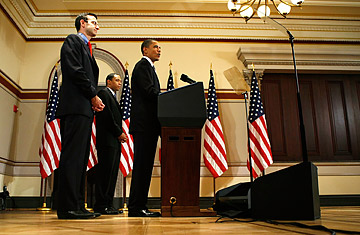
U.S. President Barack Obama (R) speaks on the FY2010 federal budget as White House Budget Director Peter Orszag (L) and Deputy Budget Director Rob Nabors (2nd-L) listen at the Eisenhower Executive Office Building of the White House.
Most company budgets and some prepared by governments have a place to park unidentified expenses. Those amounts are a hedge against unexpected needs for capital, and are often called "rainy day" funds. Budgeting purists and accountants object to these rogue figures because, in their disciplines there is no such thing as an unaccounted for account.
Details from the Administration's budget proposal show that it still contains a $250 billion line item for TARP funds which is currently identified as a "placeholder." That does not sound like a lot to money people when compared with the $3.4 trillion budget, but that is only testament to the extent to which the public is inured to fantastic sums of government spending. The $250 billion is such a casual amount in the eyes of the budget's authors that the White House said "It is there just in case that money may be needed." (See pictures of the Top 10 scared traders.)
Mr. Obama is insecure enough about the size of the deficit and presumably about falling receipts at the IRS caused by the poor economy that he recently identified 121 cuts in government spending programs which would save $17 billion. The most important unnecessary program that the Administration has discovered is the $6 million spent on The National Institute of Literacy. Also near the top of the list is $35 million for a long-range radio navigation system.
The primary reason taxpayers are skeptical about government spending is that the government is forever finding money that it should not be spending or should not have spent. The special TARP placeholder is a perfect example. Its existence means the people running the financial arms of the Administration have not made up their minds about what to do if the banking system suffers more stress or begins to collapse as it threatened to do late last year. The results from the bank "stress tests" showed that the capital needs of America's banks are modest, about $74 billion, compared to more pessimistic figures provided by the IMF and bank experts. Banks may have the option of asking the government to convert preferred shares owned by the taxpayer due to original TARP investments into common shares, or they can raise private capital. That could completely negate the need for any more direct investment by the government. The action would be bad for bank shareholders who would be diluted but good for taxpayers at least to the extent that their contributions to The Great American Bank Salvation Pool will be over. (Find out 10 things to do with your money.)
The apparent lack of need for capital by the banks coupled with the desire for the Administration to find new cost cuts in the budget should make the $250 billion "placeholder" a financial anachronism.
Someone in the government has the opportunity to be a hero by simply stepping forward and saying that there is $250 billion in the budget that does not need to be spent. The second generation of the TARP can be treated like The National Institute of Literacy. Bankers need to know how to count. Reading is a luxury.
— Douglas A. McIntyre
See the 25 people to blame for the financial crisis.
For constant business updates, go to 24/7wallst.com.
